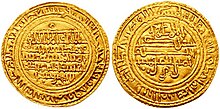Ali ibn Yusuf ibn Tashfin

Ali ibn Yusuf ibn Tashfin (died January 26, 1143 ,علي بن يوسف بن تاشفين Ali ibn Yusuf , DMG 'Alī b.Yūsuf b.Tāšufīn ) was ruler of the Berber -stämmigen Almoravids from 1106 until his death in 1,143th
history
Ali was the son of Yusuf ibn Tashfin (1060 to 1106) and a Spanish Christian. He was born in Ceuta and grew up there. He got to know the Andalusian city culture in his youth.
After the death of his father, he was confronted with an uprising by his nephew Yahya, but the residents of Fez supported his claim to rule. After taking power in 1106, he assumed the title of Amir al-Muminin ("Leader of the Believers"). He promoted mainly Andalusians in the administration and supported scholars and poets. However, he was not always able to assert himself against the powerful tribal leaders of the Almoravids in the army and administration. As a counterbalance, a mercenary force of captured Christians was built under the leader Reverter de la Guardia in the 1120s .
Although under the leadership of his brother Tamim ibn-Yusuf a victory was initially achieved in the Battle of Uclés (1108), Ali ibn Yusuf soon took over the military leadership - he succeeded in subjugating Saragossa (1110) and driving the Pisans from the Balearic Islands (1115). However, there were setbacks soon: His attempt to recapture Toledo (1109) failed ; the cities of Tudela (1114) and Saragossa (1118) were also lost to Navarra and Aragon, respectively. In 1125 the Almoravids suffered a defeat at Lucena against Aragon. Its expansion could be stopped with the victory of Fraga in July 1134. In the period that followed, some of the Mozarabs were resettled to Morocco in order to withdraw potential sympathizers from the Christians during their campaigns in Al-Andalus .
Ali ibn-Yusuf died retired from office in January 1143.
meaning
Under Ali ibn Yusuf, the Almoravid movement began to become increasingly rigid. Their legal scholars insisted on the absolute sovereignty of interpretation in religious questions and began to pursue other views. The resulting decline in the spiritual cohesion of the Almoravids was alarming insofar as the empire with its powerful provincial princes was only loosely organized and the Islamic legal scholars were an important support for the ruler.
Even if Ali ibn Yusuf was not a great military leader, he was able to maintain the existence of the empire and also keep the Almohad movement, which had emerged since 1120, under control.
Succession
After his death, the rapid collapse of the empire began under Tashfin ibn Ali (1143–1145), Ibrahim ibn Tashfin (1145) and Ishaq ibn Ali (1146–1147). As early as 1147, with the conquest of Marrakech, power fell to the Almohads under Ibn Tumart .
buildings
In addition to the construction of a new palace and a (destroyed) mosque in Marrakech, the Great Mosque of Tlemcen was significantly rebuilt under Ali . The Qarawīyīn Mosque in Fez was also expanded. Andalusian influences were increasingly noticeable in the architecture. These can also be seen in the only surviving tomb from Almoravid times, the Koubba el-Baadiyn in Marrakech, completed around 1117 .
literature
- Ulrich Haarmann : History of the Arab World. Edited by Heinz Halm . 4th revised and expanded edition. CH Beck, Munich 2001, ISBN 3-406-47486-1 , pp. 297-298 ( Beck's historical library ).
- Wilhelm Hoenerbach : Islamic history of Spain. Translation of the Aʿmāl al-aʿlām and additional texts. Artemis, Zurich et al. 1970 ( Die Bibliothek des Morgenlandes ).
- Stephan Ronart, Nandy Ronart: Lexicon of the Arab World. A historical-political reference work. Artemis Verlag, Zurich et al. 1972, ISBN 3-7608-0138-2 .
- Évariste Lévi-Provençal : Reflexions sur l'empire almoravide au début du XIIe siècle. In: Évariste Lévi-Provençal: Islam d'Occident. Études d'histoire médiévale. Maisonneuve, Paris 1948, pp. 239-256 ( Islam d'hier et d'aujourd'hui 7, ZDB -ID 1190363-6 ).
- The Encyclopaedia of Islam. New Edition . Brill, suffering. Volume 1. p. 389.
Web links
| predecessor | Office | successor |
|---|---|---|
| Yusuf ibn Tashfin | Almoravid ruler 1106–1143 |
Tashfin ibn Ali |
| personal data | |
|---|---|
| SURNAME | Ali ibn Yusuf ibn Tashfin |
| ALTERNATIVE NAMES | علي بن يوسف بن تاشفين (Arabic) |
| BRIEF DESCRIPTION | Almoravid ruler (1106–1143) |
| DATE OF BIRTH | 11th century |
| PLACE OF BIRTH | Ceuta , Andalusia |
| DATE OF DEATH | January 26, 1143 |
